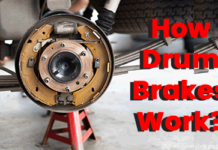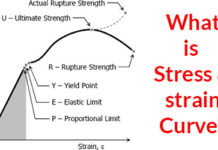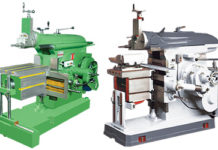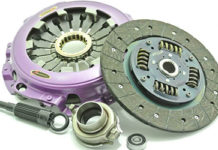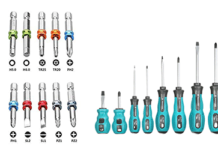Contents
- 1 Centrifugal Pump
- 1.1 Centrifugal Pump Working
- 1.2 Applications of Centrifugal Pump
- 1.3 What are the types of centrifugal pumps?
- 1.4 What is Pump Head?
- 1.5 Centrifugal Pump categorized by Impeller Design
- 1.6 Centrifugal Pump types base on Industry Standard
- 1.7 Centrifugal Pump Classify by type of Volute
- 1.8 Centrifugal Pump classify by Bearing Support
- 1.9 Limitations of Centrifugal Pump
- 1.10 Final Words
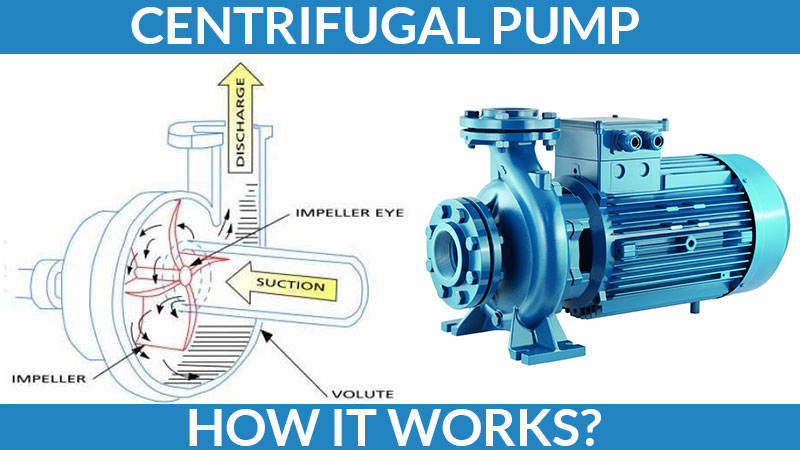
Centrifugal Pump
Centrifugal pump is used to transfer fluids from one location to another via one or more driven rotors known as impellers. The fluid enters into a rapidly rotating impeller with its axis and casts out by centrifugal force with its circumference through impeller’s vane tips. This action of the impeller increases the velocity of the fluid and also the pressure directs it towards the pump outlet. Pump casing is designed to constrict the fluid from the pump inlet and direct it to the impeller and control and slow down the fluid before discharge.
Now let’s understand
Centrifugal Pump Working
In the centrifugal pump, the impeller is the main component. It has a series of curved vanes. These vanes are between two discs and it is known as an enclosed impeller. For the fluids and entrained solids, the open or semi-open impeller vanes are preferable. In simple words, the centrifugal pump converts the rotational energy from the motor to the moving fluid.
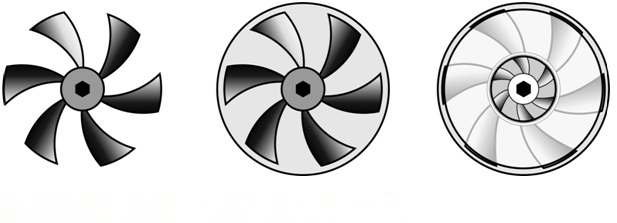
In this process of conversing of energy, the impeller and casing are used. The impeller rotates in the pump and casing is an airtight passage surrounds the impeller. In the centrifugal pump, the fluid enters into the casing and falls on the impeller blades and it is whirl tangentially and radially until it leaves the impeller from the diffuser part of the casing. This process gives the fluid both velocity and pressure.
The pump casing has two designs one is volute and the second is diffuser. The main purpose of both designs is to transfer and discharge the fluid with controlled pressure.
In the volute casing, the impeller is offset and create the curved funnel with the increasing cross-sectional area to the pump outlet. This design increases the fluid pressure at the output shown in the below image.
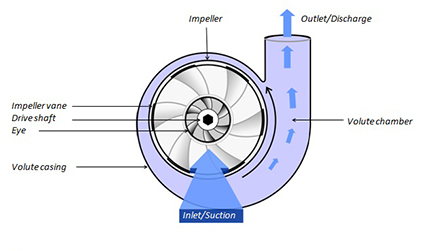
The principle remains the same for the diffuser casing. In the diffuser case, the fluid pressure increases as the fluid are expelled between the set of stationary vanes surrounding the impeller. The diffuser design is used for particular applications and it is more efficient. The volute cases are better for entrained solids or high viscosity fluids.
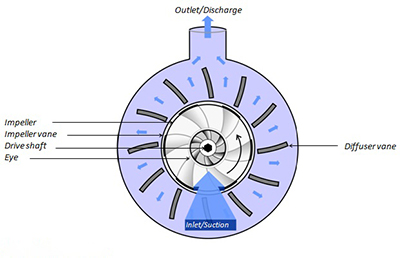
Here are some factors which affect the performance of the centrifugal pump and also required consideration before choosing a centrifugal pump.
👉 Working Fluid Viscosity
It is defined are resistance to shear when energy is applied. In simple words, the centrifugal pump is suitable for low viscosity fluids as the pumping action generates high liquid shear.
👉 Specific density and gravity of working fluid
The density of a fluid is its mass per unit of volume. The fluid’s mass per unit volume and gravity of a fluid is the ratio of a fluid’s density to the density of water and which is direct affects the input power required for a pump. If the liquid is other than water, it is important to consider the density and gravity as it is directly affecting the performance of the pump.
👉 Operating temperature and pressure
The temperature and pressure are important aspects of any pumping condition. For example, the high-temperature pumping may require special gaskets, seals and also mounting designs. In addition, the proper design pressure-retaining casing required for high-pressure pumping.
👉 Net Positive Suction Head (NPSH) and Cavitation
NPHS is used to determine the pressure of the fluid on the suction side of a pump to find that the pressure is high enough to avoid cavitation. Cavitation is a process of formation of bubbles or cavities in liquid which developed in areas like around the impeller where there is low pressure. This low pressure causes serious damage to the impeller and also make a decline in inflow/pressure among other things. For the health system, the net positive suction head available (NPSHA) is greater than the pump’s net positive suction head required (NPSHR) with a proper safety margin.
👉 Vapour pressure of working Fluid
Vapour pressure of the fluid is pressure where the fluid is converted into vapor at the given temperature. It is most important to avoid cavitation and also the bearing damage by running dry when fluid is evaporated.
Applications of Centrifugal Pump
The centrifugal pump is the most preferable choice for fluid transport from one place to another. It is used in various industries for supplying water, boosting pressure, pumping water for domestic use, hot water circulation, sewage drainage and so on. There are more
| Type of Centrifugal Pump | Application | Features |
| The Canned motor pump | Hydrocarbons, chemicals where any leakage is not permitted | Sealless; impeller directly attached to the motor rotor; wetted parts contained in the can |
| The Magnetic drive pump | Sealless; impeller is driven by close-coupled magnets | |
| The Chopper/grinder pump | Wastewater in industrial, chemical and food processing/sewage | Impeller fitted with grinding teeth to chop solids |
| The Circulator pump | Heating, ventilation and air conditioning | Inline compact design
|
| The Multistage pump | High-pressure applications | Multiple impellers for increased discharge pressures |
| The Cryogenic pump | Liquid natural gas, coolants | Special construction materials to tolerate low temperature |
| The Trash pump | Draining mines, pits, construction sites | Designed to pump water containing solid debris |
| The Slurry pump | Mining, mineral processing, industrial slurries | Designed to handle and withstand highly abrasive slurries |
What are the types of centrifugal pumps?
The centrifugal pump has many different types based on factors like design, construction, application, service, compliance with national or industry standard, etc. Some of the pump types are explained below:
👉 Single Stage – One impeller pump. This pump has a simple design and easy maintenance. This type is suitable for large flow rates and low-pressure installations. The single-stage pump is commonly used in pumping services of high flow and from low to moderate TDH (Total Dynamic Head).
👉 Two Stage – Two-stage pump has two impellers operates side by side and is suitable for medium head applications.
👉 Multi Stage – This type of pump has three or more impellers in series for high head service.
What is Pump Head?
The pump head is pressure defined as the height to which the pump can raise the fluid. It is important as it shows the pump’s capacity. The important factor considers of the pump is its capability of flow and pressure.
Case-Split
It is another factor that is considered for a centrifugal pump.
👉 Axial Split
For this type of pump, the volute case is split axially and the split line at which the pump casing separate is at shaft’s center-line. This type of pump is mounted horizontally for easy installation and maintenance.
👉 Radial Split
The pump case is split radially. The volute casing split is perpendicular to the shaft center-line.
Centrifugal Pump categorized by Impeller Design
👉 Single Suction
This type of pump has a single suction impeller and the fluid is entering into blades via one side only. Single suction has a simple design but impeller has higher axial thrust imbalance as the flow coming from only one side of impeller only.
👉 Double Suction
This kind of pump has a double suction impeller where the fluid is entering from both sides of the blade also has lower NPHSR than a single suction impeller. The split-case pumps are the most common type of pump of having a double suction impeller.
Centrifugal Pump types base on Industry Standard
👉 ANSI Pump (American National Standards Institute)
It refers to the dimensional standards. The pumps have to meet ANSI B73.1 standard also known as ASME B73.1 (American Society of Mechanical Engineers). This is standard ensures the interchangeability of ANSI process pumps of similar sizes. These types of centrifugal pumps are horizontal, end suction, single-stage pumps and also regardless of manufacturer.
👉 API Pump (American Petroleum Institute)
API’s standards are for parameters of the pump’s construction, design, and has the ability to handle high temperatures and pressures. The API 610 and other API types are API VS4, API VS7, API OH3, API OH2, API OH2, API BB1, API BB2, API BB3, etc. These types of pumps must have to meet the requirements of American Petroleum Institute Standard 610 for General Refinery Service.
👉 DIN Pump
DIN 24256. The centrifugal pumps have to satisfy these standards to installing for large flow rates, abnormally high working pressures or very high temperatures. It is rarely used in mechanical building services.
👉 ISO Pump
The ISO 2858, 5199 standards. The international standards ISO 5199 specifies the standards for class ll end suction centrifugal pump of single-stage, multistage, horizontal or vertical construction. And for any drive and any installation for general application.
👉 Nuclear Pump
ASME (American Society for Mechanical Engineers) Specifications.
Centrifugal Pump Classify by type of Volute
The centrifugal pump is also categorized by volute also like Single Volute and Double Volute.
👉 Single Volute
This type of pump is mainly used in the small low capacity pump where a double volute design and it is also impractical as it has a comparably small size of the volute passageway. This type of pump has higher radial loads.
👉 Double Volute
The double volute pump has two partial volutes which are located 180 degrees apart resulting in balanced radial loads. The most centrifugal pumps have a double volute design.
Centrifugal Pump classify by Bearing Support
👉 Overhung
The impeller is mounted on the end of a shaft and supported by bearings on one side only. Moreover, the overhung pump type has a horizontal orientation of shaft or it can be vertical in-line with bearing bracket.
👉 Between-bearing
The impeller is mounted on a shaft and has bearing support on both ends and the impeller is located in between-bearings. The example of between-bearing is the axial split vertical split case.
The shaft orientation is also an important factor to categorized the centrifugal pump.
👉 Horizontal
This type of pump has a shaft in the horizontal plane. It is very popular as it has easy service and maintenance. Sometimes it is overhung or placed between bearing design.
👉 Vertical
The vertical centrifugal pumps have their shaft in the vertical plane. It uses the unique shaft and bearing support which allows the volute to hand in the sump and the bearings are outside of the sump. This is an overhung and of radial-split case type design.
Limitations of Centrifugal Pump
For the constant operation of a centrifugal pump, it relies on the constant and high speed of its impeller. If there is high viscosity feed the centrifugal pumps become inefficient and greater resistance and higher pressure is required to maintain the flow rate. Which make the centrifugal pumps are suitable for low pressure, high capacity, pumping applications of liquids having a viscosity between 0.1 and 200 cP.
For thick liquids like slurries and mud, high viscosity oil can damage and overheat can cause failure. The positive displacement pumps operate at a relatively lower speed and having fewer problems.
Any material that is sensitive to shearing (separation of emulsions, slurries or biological liquids) can be damaged by the high speed of the pump’s impeller. The lower speed of a positive displacement pump is very suitable.
Ahead in the list, the next limitation is, opposite the positive displacement pump, the centrifugal pump cannot suction with the dry condition. Firstly, it must be primed with the pumped fluid. The centrifugal pumps are not suitable where supply is intermittent. Additionally, if there is variation in feed pressure, the centrifugal pump produces a variable flow. On the contrary, the positive displacement pump is not sensitive to change in pressure and provides constant output. For accurate dosing the positive displacement pump is preferable.
Final Words
The design of Centrifugal Pump is simple and also a cost-effective solution for low pressure, high capacity pumpings like viscosity fluids like water, solvents, chemicals, and light oils. Most common applications like water supply and circulation, irrigation and transfer the chemicals in petrochemical plants.
So, this is the information about Centrifugal Pump, different types of pump and centrifugal pump working.
🔔We hope this information will help you. For more new information click on the notification button and get regular updates from Unbox Factory.
Now if you find this information helpful, share it with your friends, family, and colleagues.
If you like this post, let us know by comment below, if you want to add-on information about this topic, comment the information. We will consider the information if it is relevant.
Thank you for reading.

